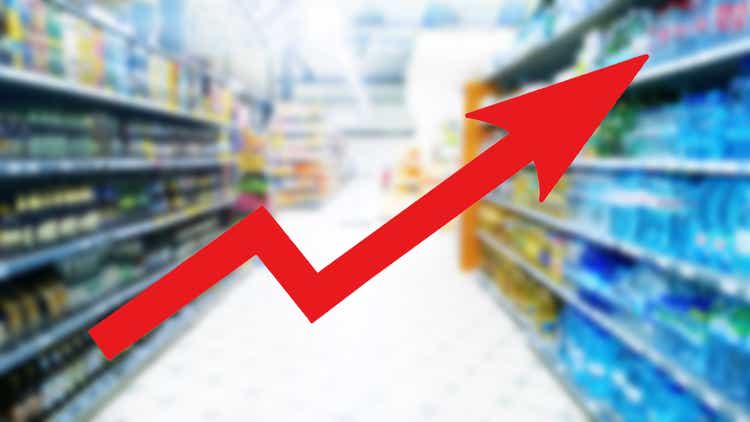NVS/iStock via Getty Images
Business leaders trying to understand what inflation means for their companies will be handicapped if they pay attention to news reports about policy responses. Here are two misleading statements. President Biden wrote in the Wall Street Journal, “Inflation is elevated, exacerbated by Vladimir Putin’s war in Ukraine.” Senate Republicans criticized the president’s efforts to reduce oil and gas production saying it “has contributed to soaring inflation.”
What the two sides miss is that inflation is not really about high oil and gas prices. Understanding what is really causing inflation will help us understand how bad inflation will be and how long it will last.
The word inflation was first used to describe an increase in the money supply. Only in the last century has it come to mean a general increase in prices. And there’s the hint about how inflation comes about.
Inflation is the increase in the average price level over a period of time. Milton Friedman said, “Inflation is always and everywhere a monetary phenomenon in the sense that it is and can be produced only by a more rapid increase in the quantity of money than in output.”
So how do rising gasoline and food prices figure into it? Economists think of inflation as price increases that are persistent and broad. Persistent means that we are seeing prices rise month after month, year after year. Broad means that a wide variety of prices are rising, not just prices of a few goods, and certainly not one price rising while another falls..
So what happens when we experience something like a jump in oil prices triggered by reduced Russian supply to world markets? Rising gasoline prices push up the Consumer Price Index, but there’s no reason to expect this to be persistent. Rather, it’s a one-time shift to a higher price level. So if we had experienced seven percent inflation, and then an increase in gasoline and related prices that pushed the price level up once by a single percent, the result would be the CPI rising by eight percent, explained mostly by money growth plus one percentage point caused by the change in gas prices. After that, we would resume the old seven percent rate of inflation. With the common 12-month calculation of percent changes, it will take a year for the gas price increase to work through the statistics, but this is really a one-time shift in the price level.
Let’s look at actual numbers. In the 12 months through January 2022, the CPI rose by 7.5%. Russia invaded Ukraine on February 24, 2022. Our most recent reading of the CPI increased 8.6%. (For perspective, the CPI rose 2.3% over the course of 2019, before the pandemic.)
Whether gasoline price hikes are more a result of Vladimir Putin’s invasion of Ukraine or the Biden administration’s efforts to reduce fossil fuels use is irrelevant: Inflation has been caused by monetary stimulus in excess of increases in our productive capacity.
To understand the likely end of this inflation, we look to monetary policy. The Federal Reserve has begun tightening, has a lot more to do, and their actions take a long time before affecting inflation.
Even though the Fed approved a small increase in short-term interest rates in March 2022, their total credit extended, the measure of their overall monetary policy, continued to rise in April. Only in May 2022 did total Federal Reserve credit drop – by just three hundredths of one percent. The pace will certainly pick up through the rest of 2022. The Fed is likely to raise interest rates in steps while reducing their holdings of long-term bonds and mortgage-backed securities. However, they are not talking about a large sudden change. Instead, they will implement changes gradually.
The time lags in monetary policy, Friedman argued, are long and variable. Many economic models put the average time lag at about two years. The Fed’s own dynamic stochastic general equilibrium model has a shorter time lag, just one year. Even with that optimistic view, a year from now the gradual implementation of the new policy will just be starting to take effect. And the many economic models that have found longer time lags would be even more pessimistic about improving inflation.
Eventually inflation can be brought down to the Fed’s target of two percent, but only if the Fed remains steadfast. Time lags to changes in employment are shorter, just one year in the common economic models. So in one year we could be seeing a slowing job market and just a little improvement in inflation. If the Fed persists in tightening then, they will confront strong political opposition. Whether they have the confidence to persist is an open question that will determine whether inflation becomes deeply embedded in the economy or dies off in a couple of years.
An early example of misleading inflation thinking was President Ford’s effort of 1976. He encouraged people to be smart consumers and to wear buttons that said WIN, which stood for Whip Inflation Now. Skeptics wore their buttons upside down to spell NIM: No Immediate Miracles. Skeptics regarding a quick solution to the current inflation will be proved right once again.
Editor’s Note: The summary bullets for this article were chosen by Seeking Alpha editors.


Be the first to comment